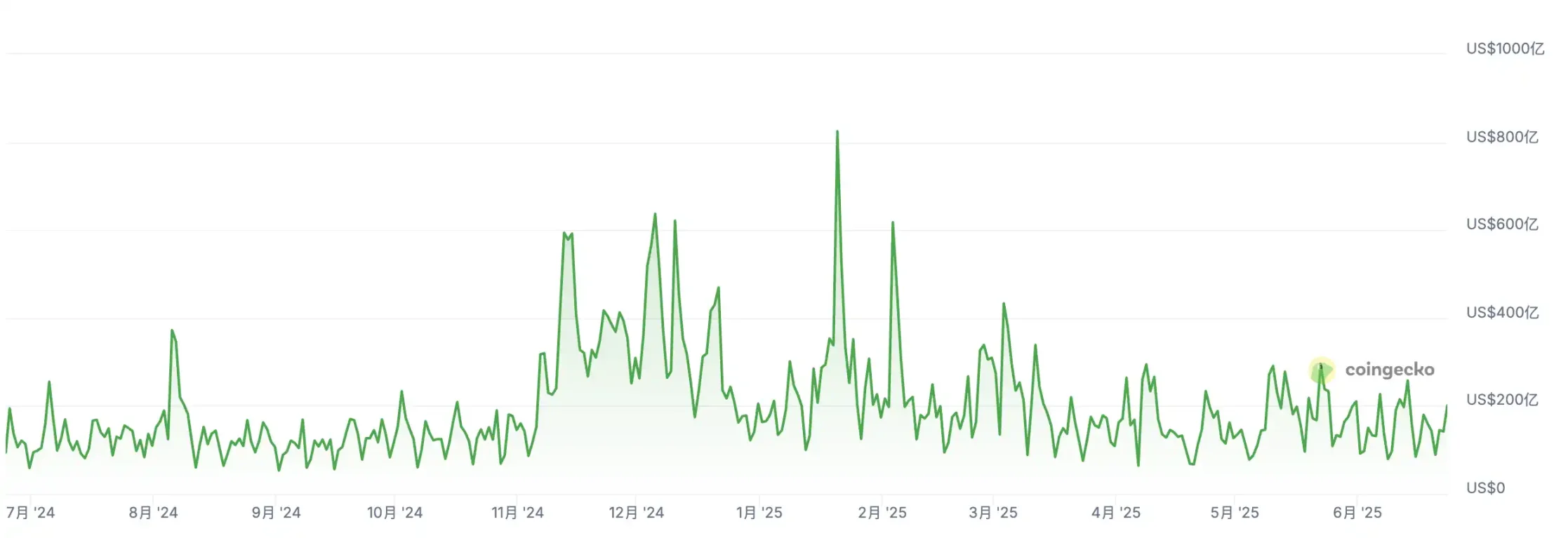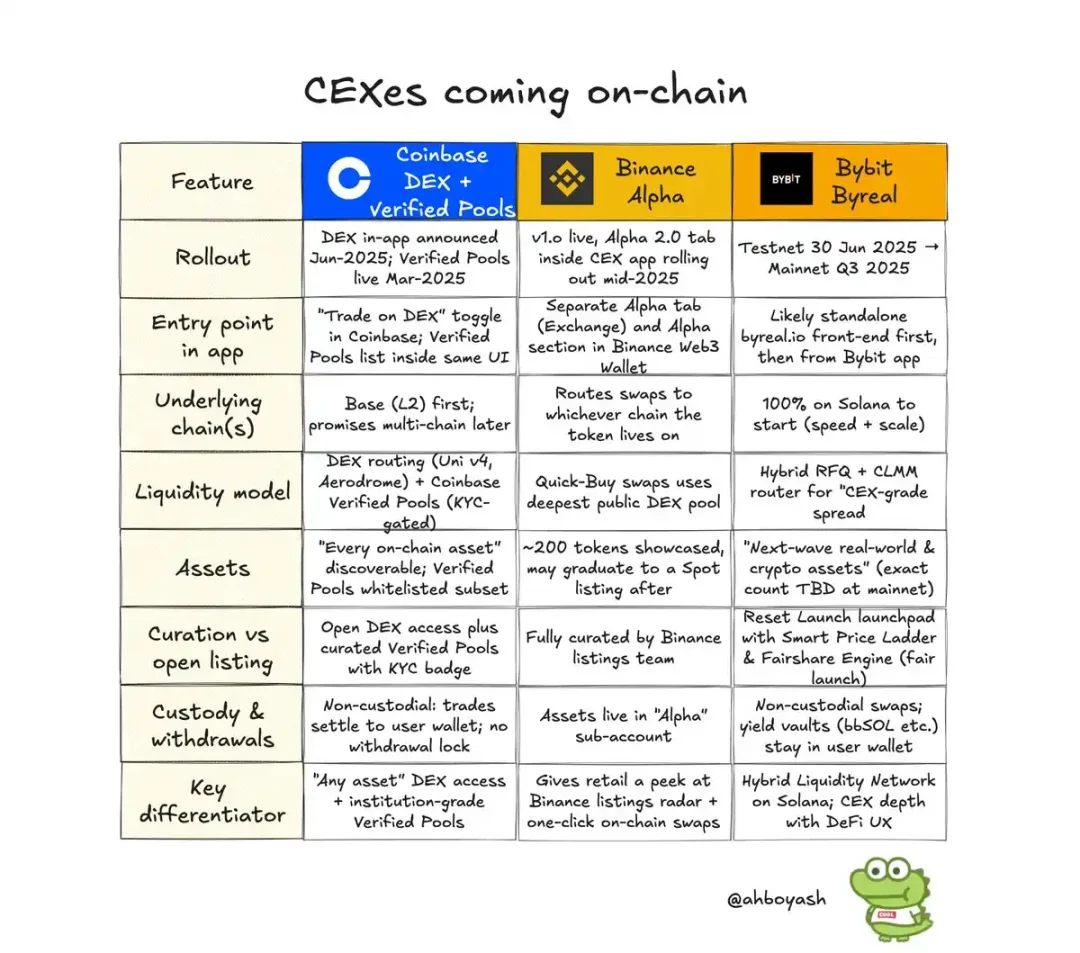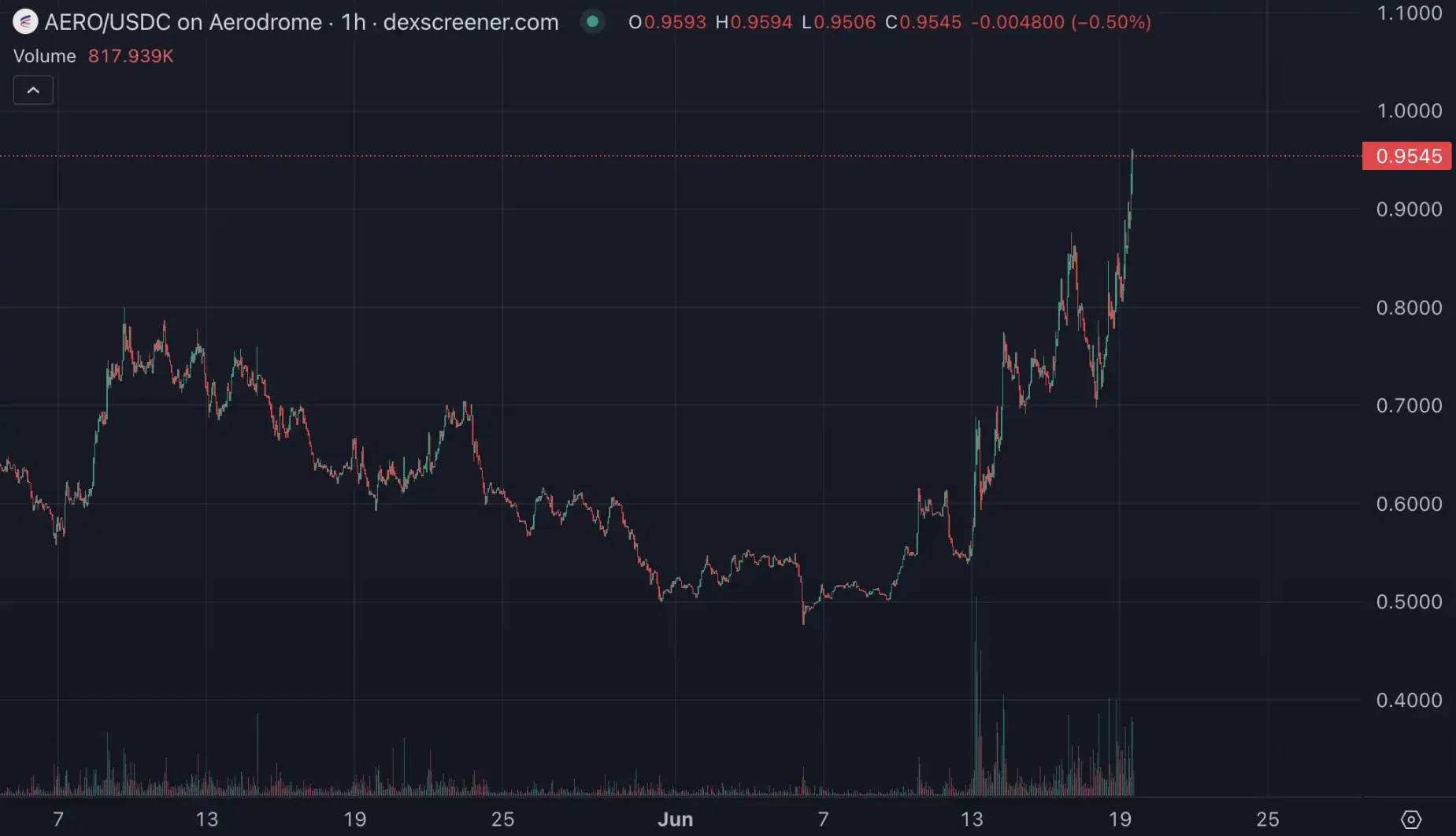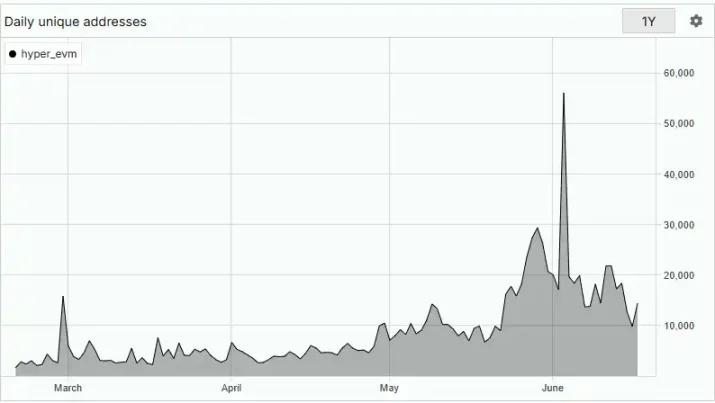Written by: BUBBLE,BlockBeats
Centralized exchanges are experiencing a collective directional adjustment. From Coinbase spending nearly $2.9 billion to acquire the derivatives trading platform Deribit and collaborating with Shopify to promote USDC adoption among physical merchants, to Binance launching the Alpha program to reshape primary market pricing mechanisms, to Kraken acquiring NinjaTrader to expand the options market and partnering with Backed to launch "US stocks" business. Bybit has also opened trading for gold, stocks, forex, and even oil indices on its main platform.
Top trading platforms are actively expanding their revenue sources, attempting to achieve multi-dimensional business "replenishment" from off-chain to on-chain, from retail to institutional, from mainstream coins to Altcoins. Meanwhile, these platforms are also extending their tentacles into the on-chain ecosystem. Taking Coinbase as an example, its main site has integrated DEX routing on the Base chain, intending to break down the liquidity barriers between CeFi and DeFi and reclaim the trading share lost to on-chain protocols like Hyperliquid.
However, behind these moves is the continuous pressure on the actual revenue capabilities of trading platforms, with crypto trading platforms facing an unprecedented development bottleneck. Coinbase's latest financial report shows that its trading fee revenue has been halved from $4.7 billion in 2024 to $1.3 billion in Q1 2025, a quarter-on-quarter decline of 19%. The trading volume of BTC and ETH has dropped from 55% in 2023 to 36%, with revenue structure increasingly dependent on the more volatile Altcoin sector. Meanwhile, operating costs have not decreased, reaching $1.3 billion in the first quarter of 2025, almost equal to its revenue. Binance also faces the challenge of declining trading fees, with the average trading fee revenue from the end of 2024 to now hitting a three-year low, despite still leading in market share.

Binance's trading volume has been mostly sluggish in the past year, source: coingecko
With trading fee space being compressed, on-chain liquidity continuously diverting, and traditional brokers reshaping compliant entry, these intertwined forces are forcing CEX to transform into "on-chain platforms". Well-known KOL ASH analyzed on X that as more DEXs improve their trading mechanisms, giving birth to products that almost match CEX user experience but with more transparent trading processes, CEX has finally noticed this and begun shifting strategic focus to permissionless modes, with many CEXs launching a market battle for "on-chain CEX".

OKX Focusing on Infrastructure Development
In the OKX annual letter on December 30, 2024, OKX founder Star Xu stated his belief that "true decentralization will lead to the mass adoption of Web3" and is committed to building a bridge connecting traditional and decentralized finance.
This is not without basis. OKX is one of the earliest and most systematically deployed centralized exchanges in on-chain infrastructure, second only to Binance. It is not sporadically launching a wallet or feature, but constructing a Web3 operating system that can replace centralized scenarios with a "full-stack construction" approach, creating a closed loop with CEX user assets.
OKX has been continuously promoting its on-chain infrastructure strategic construction in the past two years, attempting to transform from a centralized exchange to a core participant in the Web3 operating system. One of its key focus areas is OKX Wallet (a non-custodial wallet supporting over 70 public chains), which integrates Swap, NFT, DApp browser, inscription tools, cross-chain bridge, and yield vault in the Web3 sector.
OKX Wallet is not a single product but the core hub of OKX's Web3 strategy, connecting users with on-chain assets and bridging centralized accounts with on-chain identities. With its comprehensive components, many newcomers who joined the crypto space in 2023 first experienced on-chain interactions through OKX Wallet.
On the other hand, OKX continues to invest in underlying networks and developer ecosystems. It launched OKExChain (later renamed OKTC), an EVM-compatible L1 public chain, as early as 2020, though the chain was not widely embraced by the market. To support the chain's development, OKX simultaneously launched block explorers, developer portals, contract deployment tools, and faucet services, encouraging developers to build DeFi, GameFi, and NFT applications within its ecosystem.
By continuously hosting hackathons and launching ecosystem support funds, OKX is forming a complete closed-loop on-chain ecosystem. Although OKX has never publicly disclosed the total investment amount, the market generally estimates that its investment in on-chain infrastructure, including wallet, chain, bridge, tools, and incentive systems, has exceeded $100 million.

Binance Alpha: Monetizing Reputation and Liquidity
In 2024, the crypto market welcomed a bull market boom under the dual stimulation of Bitcoin spot ETF approval and meme coin frenzy. Despite seemingly significant liquidity recovery, hidden beneath the prosperity is the gradual failure of pricing mechanisms between primary and secondary markets. Project valuations continue to inflate in the VC stage, token issuance cycles are repeatedly extended, and the participation threshold for ordinary users keeps rising. When tokens finally list on trading platforms, it often becomes an exit for project parties and early investors, leaving retail investors with price collapse after "peak at listing".
It was in this market environment that Binance launched Binance Alpha on December 17, 2024. What was originally an experimental feature in the Binance Web3 wallet for exploring quality early-stage projects quickly evolved into a key tool for Binance to reshape the on-chain primary market pricing mechanism.
Binance co-founder He Yi once openly acknowledged in a Twitter Space response to community controversy that Binance's token listing has a structural "peak at listing" problem and frankly admitted that traditional listing mechanisms are difficult to sustain under current trading volume and regulatory frameworks. In the past, Binance tried to correct pricing imbalances after new token listings through voting and Dutch auctions, but the effects were never satisfactory.
The launch of Binance Alpha became a strategic alternative to the original listing system within a controllable range. Since its launch, Alpha has introduced over 190 projects from ecosystems like BNB Chain, Solana, Base, Sonic, and Sui, gradually forming an early-stage project discovery and preheating platform led by Binance, providing an experimental path for trading platforms to regain initial pricing rights.
After the Alpha Points mechanism was launched, it became a paradise for retail users to "farm" rewards. Not only crypto players but even those from the broader Web2 domain were attracted by the good returns, with many mobilizing entire families, companies, and even villages to participate.
Although it has become increasingly competitive, with some tokens like ZKJ experiencing significant drops after Alpha listing, raising concerns about its "compliance", community opinions are mixed. Well-known KOL thecryptoskanda highly praised Alpha, considering it Binance's second greatest innovation after Binance IEO. Analyzing its role in the ecosystem, he believes "Binance Alpha's historical mission is to dismantle the primary pricing rights of North American VCs like a16z and Paradigm, who can almost costlessly raise funds from traditional finance, and reclaim the Binance ecosystem. It will also crush the Altcoin listing market of other trading platforms to prevent scenarios like Grass emerging on Bybit and causing hot spots to shift, while channeling all chain liquidity through BSC into Binance's liquidity. Alpha has successfully accomplished these three goals."

Coinbase Connects to DEX, In-house Whales Giving Back to Base
Following Binance and OKX's footsteps, Coinbase has also begun integrating its on-chain ecosystem. Their initial strategy is to access DEX trading and verified liquidity pools. At the recent 2025 Crypto Conference, Coinbase's Consumer Product Management Vice President Max Branzburg announced that DEX trading from the Base chain will be integrated into the Coinbase main application, with future applications embedding DEX trading.
Trade any chain tokens through Base's native routing and wrap them into KYC-verified liquidity pools, enabling institutional participation. Coinbase now has over 100 million registered users, with 8 million monthly active trading users, and according to its investor report, the platform's customer asset value is $328 billion.
Retail trades only account for about 18% of Coinbase, and from 2024, the trading volume of institutional clients has been continuously increasing (Q1 2024 trading volume was $256 billion, accounting for 82.05% of total trading volume). With Coinbase integrating DEX on Base, the breadth of DeFi combined with TradFi's compliance standards should introduce massive liquidity for thousands of Base chain tokens, and more importantly, many Base ecosystem products will have the possibility of a compliant pathway through Coinbase.
Base's largest native DEX, Aerodrome, has also become a hot topic these days. As one of the first embedded trading routes on Coinbase's main site, it has risen by 80% in the past week, with its market value increasing by nearly $400 million.

The community's attitude is divided. Famous KOL thecryptoskanda is not optimistic about Coinbase's strategy, believing that Coinbase is merely mimicking Binance Alpha by superficially opening the app to buy Base chain assets. However, KOL decoder 0xBeyondLee argues that this is not the same as Binance Alpha, stating, "Alpha has an access mechanism and not just any token can be listed. Coinbase's approach allows all Base assets to appear, which is as absurd as directly trading the stock of a fruit stall downstairs on Tonghuashun. This is unprecedented in terms of liquidity and attention for the Base chain."

Famous KOL TheSmartApe "the_smart_ape" stated on social media that due to Coinbase's actions, he will start selling $Hype, which he has held since TGE. He further explained that Hyperliquid currently has about 10,000 to 20,000 daily active users, with a total user base of around 600,000. Among them, 20,000 to 30,000 core users contribute nearly $1 billion in revenue, with a significant portion coming from the United States.

Most American traders use Hyperliquid because they have no better options. Excluded from Binance and other major CEXs, they cannot trade perpetual contracts. However, when Coinbase and Robinhood announce perpetual futures products in the US, this will be a massive blow to Hyperliquid, with a large portion of its core users potentially shifting to Coinbase or Robinhood. Coinbase, with safer and more convenient access, no self-custody requirements, no complex DeFi UX, and full support from regulators like the SEC, can attract most traders who don't care about decentralization as long as it's safe and user-friendly.
(Translation continues in the same manner for the rest of the text)When the market is filled with diverse competition, it is the most creative and vibrant. Whether it's the competition between DEX or CEX, it is the result of continuous compromise between the market and "reality". This "on-chain war" centered around liquidity dominance and user attention has far exceeded the technical aspects itself. It concerns how trading platforms reconstruct their roles, capture the needs of the new generation of users, and find a new balance between decentralization and compliance. The boundaries between CEX and DEX are becoming increasingly blurred, and the future winners belong to builders who find the optimal path among "experience, security, and permissionless".








